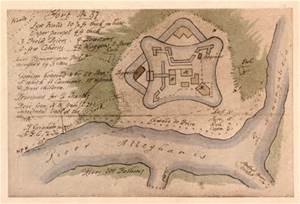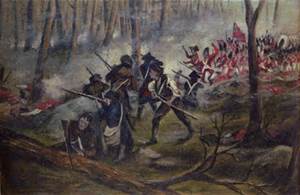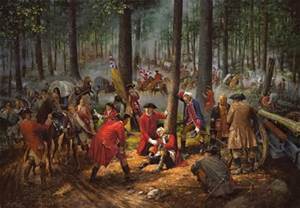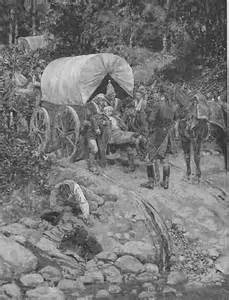Newly promoted Major General Edward Braddock arrived at Hampton Roads, Virginia in February 1755 with two regiments of regulars to assume command of  all British forces in North America. England and France were engaged in an epic struggle for control of a large part of the continent as well as colonial possessions in other parts of the world. It was a war for empire fought on a global scale.
all British forces in North America. England and France were engaged in an epic struggle for control of a large part of the continent as well as colonial possessions in other parts of the world. It was a war for empire fought on a global scale.
At a meeting in Alexandria, Virginia that April, Braddock laid out his plan to capture Fort Duquesne (modern Pittsburgh). His British regulars were augmented by nine companies of Virginia militia. Braddock had nothing but contempt for these locals, he considered them to be lazy, apathetic and useless. Naturally, there was a degree of friction between Gen. Braddock and his militia officers. One of them was a tall, former surveyor by the name of George Washington.
Braddock and Washington differed over the worth of the militia and the need to utilize Native American tribes as allies in the war against the French. Braddock could not be persuaded, he considered Indians to be worse than militia, of no value to a sophisticated military operation. Disregarding the advice of Washington and other officers with frontier experience, he curtly dismissed the offers of assistance from tribes friendly to the English. He would wage his campaign according to the rules of European warfare and teach his pathetic militia a lesson in proper military tactics at the same time.
could not be persuaded, he considered Indians to be worse than militia, of no value to a sophisticated military operation. Disregarding the advice of Washington and other officers with frontier experience, he curtly dismissed the offers of assistance from tribes friendly to the English. He would wage his campaign according to the rules of European warfare and teach his pathetic militia a lesson in proper military tactics at the same time.
After lengthy time spent gathering supplies, his army of approximately 2,200 departed Fort Cumberland (now Cumberland, Maryland) on June 10, 1755. The imposing British force made slow progress at it cut a 12 foot wide wagon road through the forested mountains. Its destination was the French fort which controlled the Ohio River at its source, the confluence of the Allegheny and Monongahela Rivers. While the British were making ready, the French garrison at Fort Duquesne had not been idle. Their pleas for assistance brought over 600 Indian warriors to the fort, some from as far away as Detroit.
The string of supply wagons and artillery toiling over the rough, newly cut road were slowing the advance. On June 19, Gen. Braddock decided to split his force. The majority of the wagons plus a guard detachment were ordered to follow behind the main force at the best speed they could manage. Braddock would press forwarded with over 1,400 soldiers, 30 wagons, the artillery and pack horses. On Wednesday, July 9, 1755, Braddock’s force was about seven miles from Ft. Duquesne.
The majority of the wagons plus a guard detachment were ordered to follow behind the main force at the best speed they could manage. Braddock would press forwarded with over 1,400 soldiers, 30 wagons, the artillery and pack horses. On Wednesday, July 9, 1755, Braddock’s force was about seven miles from Ft. Duquesne.
Even though there had been no sign of the French, flanking parties were on both sides of the army and an advance guard was out in front. Behind the main body of troops came the wagons, artillery and pack horses followed by the rear guard. It was quiet, the Monongahela River had been forded without opposition. Gen. Braddock’s cannon would shortly be in a position to bombard the fort.
The French commander, knowing the fort could not withstand a siege by a force with artillery, was considering evacuation. After a heated discussion, he gave  Captain Daniel deBeaujeu permission to try to slow down the English advance. After delivering a rousing speech to the Indians, Capt. deBeaujeu, adorned in war paint, led a force of approximately 890 from the fort. Over 630 warriors moved with him, the others were French regulars and Canadians.
Captain Daniel deBeaujeu permission to try to slow down the English advance. After delivering a rousing speech to the Indians, Capt. deBeaujeu, adorned in war paint, led a force of approximately 890 from the fort. Over 630 warriors moved with him, the others were French regulars and Canadians.
The French and Indians moved down the path toward the ford until they collided with Braddock’s force. While the French regulars and Canadians held in front of the British, the Indians infiltrated along the flanks. The British advance guard and flank contingents were quickly driven back to the main body. When the firing began, the British troops formed their standard tight formations and poured volleys of musket and cannon fire into the trees at an almost invisible enemy.
The tightly packed British regulars were confused because this was not how they had been trained to wage war. They continued to fire volley after volley into the  trees, rarely scoring a hit. The French and Indians firing from cover, riddled the exposed English columns from all sides. With British soldiers going down in heaps, the French could not believe their good luck. What was to be a delaying action was turning into a victory.
trees, rarely scoring a hit. The French and Indians firing from cover, riddled the exposed English columns from all sides. With British soldiers going down in heaps, the French could not believe their good luck. What was to be a delaying action was turning into a victory.
When the first shots were fired, the Virginians moved among the trees and returned fire. The dispersal of the militia enraged Gen. Braddock. He would not permit his troops to act like cowards and hide behind trees. He bravely moved everywhere on the battlefield, cursing his troops, beating them with the flat of his sword, driving them back into the ranks.
The battle had raged for nearly three hours when Gen. Braddock realized his army was being annihilated. Shortly after ordering a retreat, he was seriously  wounded. The general was carried from the field by the retreating survivors. So complete was the English defeat that the French did not pursue. Braddock died on July 14 as his badly mauled force limped towards Fort Cumberland.
wounded. The general was carried from the field by the retreating survivors. So complete was the English defeat that the French did not pursue. Braddock died on July 14 as his badly mauled force limped towards Fort Cumberland.
It had been a disaster for the English. Braddock’s troops had been decimated, losing 977 of those engaged. For the small French garrison and its Indian allies, it had been a victory at low cost. Their combined losses were around 60. The initiator of the astonishing triumph, Capt. deBeaujeu, was killed early in the fighting. The news of Braddock’s defeat sent a shock wave through the English colonies. The overall British commander was dead, his army nearly wiped out. The French were not going to be easily dislodged from their holdings in North America.
Although two horses had been shot out from under him and four bullets had ripped through his clothing, George Washington survived the fighting. He continued to serve, Washington was with the British force which captured Ft. Duquesne in November 1758. The experience he gained during Gen. Braddock’s ill-fated expedition would serve him well later on.
Discover more from Blog for Arizona
Subscribe to get the latest posts sent to your email.

Try the award winning “Washington” by Ron Chernow. It also covers his entire life, including his paying his London tailor at the same time his army was trying to drive British troops out of the United States. Sorry, he learned hard lessons on trusting State legislatures, something we should learn in Arizona.
I found it funny that one of Washington’s disliking being held in thrall to England – albeit a very small reason – was the fact that the Colonies had to buy all their goods from England. English merchants knew that and when filling order from the Colonies they boight 2nd quality goods and charged 1st quality prices. Washington often complained about receiving chipped and broken china, used pots and pans, etc.
Washington realized government was necessary, but he was keenly suspicious of it. George Washington said, “Government is like fire, a dangerous servant and a fearful master.” He may well have been suspicious of State governments, but he was no fan of a strong federal government either
Washington was considered a hero for getting the survivors back to Maryland and Virginia after the arrogant Braddock was killed. Begs the question of the stupidity of the clash of French-British ambitions west of the Alleghenies. Washington learned what tactics worked in the Americas and which did not. He used these experiences in the Revolution. His strategic retreat at Long Island in the face of massive British power looked like defeat, but rescued the revolution. It also taught him to be a Federalist, as the States continually promised support and did not give it. He learned he could not trust individual State promises and realized the need for a strong Federal government.
Washington believed that a strong federal government was not desireable, He thought certain functions were the responsibility of the Federal Government, but they were very limited. They included, among others, national defense, international affairs and arbitration of problems between the states. One of the best biographies on Washington is “All Cloudless Glory”. The book covers his entire life and talks about his ancestory going back to England. It gives great insights into one of the most interesting and influential men in American history.
Good, concise story telling. I always enjoy your history lessons!